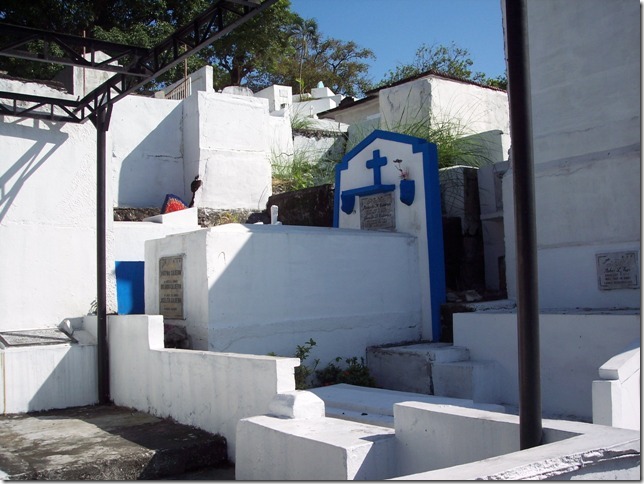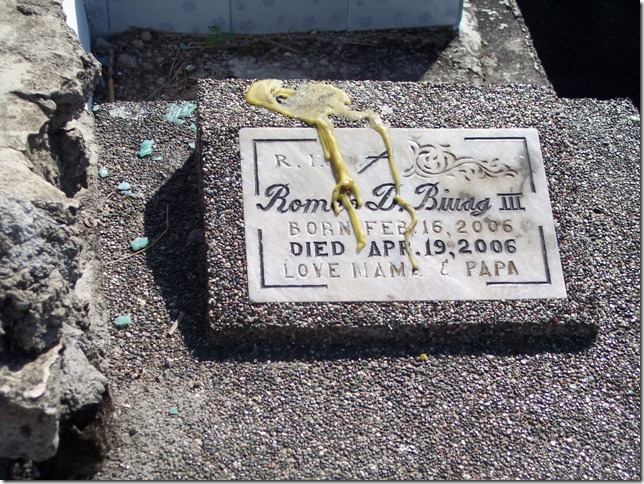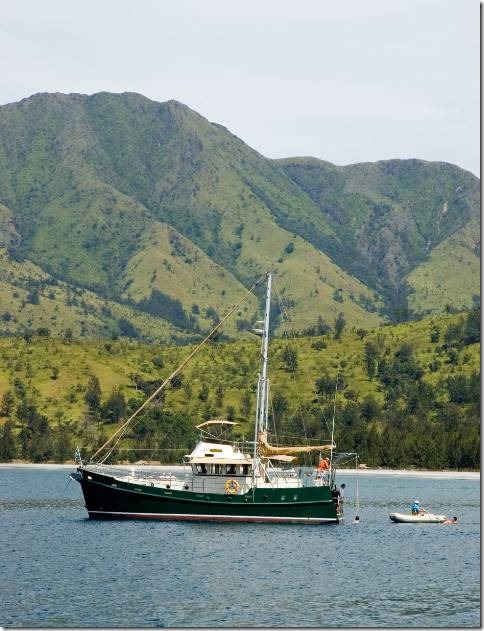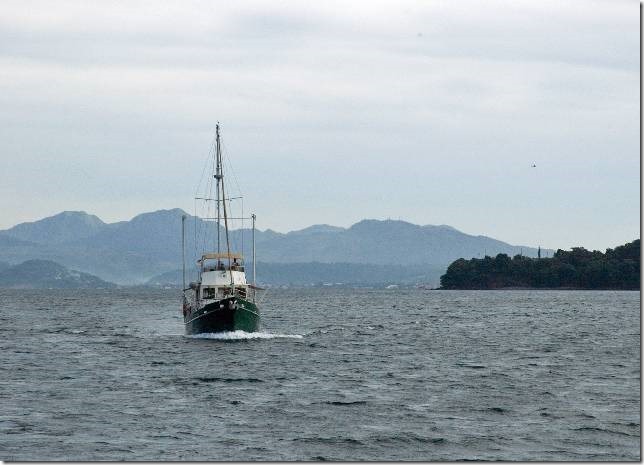Hi Everyone,
This is Randal’s email to Duck Talk, a group of Diesel Duck owners, future owners, and dreamers.
Lessons Learned
And we just got started. I can tell you that if you never go cruising, this boat can be built much cheaper. You don’t need an anchor, windless, or anchor chain. You don’t need sails and mast, fuel or fuel tanks, or a polishing system, flopper stoppers, navigation equipment, communication equipment, dinghy, gen-set, watermaker, prop, or even an engine. As a matter of fact you can use the engine room for a cabin for your teenage stepson or my preference, a bar, complete with pool table and outside entrance for ladies. Don’t worry about the cost of the outside entrance, with the money you save you can get a Diesel Duck 964 and have money left over.
Ruth and I took Dora Mac for her first real outing leaving Subic Bay on Thursday, November 8th and returning on the 17th. We were very fortunate to have made friends with the fellow across the dock from us, Nick Spence. Nick is retired now and lives primarily on his sailboat, Stargazer, with his companion Zaida. Nick has been a mariner all his life and was involved in the three year design and build of a 166’ yacht by the name of Double Haven. He went on to captain the boat for thirteen years and circumnavigate three times. There is little Nick does not know about this business of cruising and luckily he has been willing to share it with Ruth and me.
I had been quizzing Nick ever since I met him and it was he who suggested we go cruising among some of the Philippine Islands and take him and Zaida along. It was like Roy Rogers riding into my living room when I was eight years old and suggesting that he and I go horseback riding. Nick is a captain’s captain, he even has a captain’s Pavarotti voice that he can bring out at any time he thinks necessary. One thing for sure he knows boats and boating, he even knows wind, waves, and currents and more importantly how to predict them.
So off we four go with all the enthusiasm that kissing the good dock goodbye can offer, at least for Ruth and me. I think that Nick genuinely likes these Diesel Ducks. They’re a solid ship he says, and the rugged exterior gives little hint as to the quality, appearance, and comfort of the interior. He did share some observations with me about some changes he would have made that made perfect sense. Some of these were just little annoyances like the water dripping in after a rain when you open the hatches while others were more serious and modifications will have to be made.
Our first stop was a little secluded almost uninhabited place called Himilo Cove just south of Manila Bay, about 50 miles and eight hours from Subic. Next was Puerto Galera for a few days before heading dead east to Marinduque. We had planned to spend a day just for a rest before heading south to Romblon but the wind got up and we spent an extra day there. The third day the wind was still howling and there was little protection heading south so we decided to head back to PG.
I lost my breakfast for the first time since we took delivery. Nick, always politically correct, said he was impressed I knew to throw up on the down wind side. I added that I also took into consideration the proximity to the water hose. It was very uncomfortable to say the least.
We discovered all the things that weren’t tied down but should have been. We had substantial seas coming from our starboard quarter. We did have our paravane polls out and I saw the port side one dip into the water on one severe roll.
We had put the flopper stopper fish into the water and they put on quite a show, sometimes upside down gliding along on top of the water like a dead mackerel and at other times sailing in and out of the water like a flying fish. These were of my design and now my junk so I will have to hunt down a set of professionally designed ones like everybody else uses.
We were so concerned that they would take a flying leap into the boat that Nick immediately turned the boat into the wind and he and I wrestled them aboard. While we were into the wind Nick suggested we put up the mainsail for stabilization and my breakfast departed soon after. It was comforting when Nick later told me not to be too concerned about the seasickness, that I would learn a way to deal with it. Maybe leaving the scotch off the dinner menu the night before might help. Oh the sacrifices one makes for the pleasure of cruising.
There were a few minor medical issues on our cruise. Nick, who had broken a small bone in his right foot on a recent trip home, reinjured it as we were preparing to go. He had to be very careful where he stepped and the flybridge ladder was a challenge. Ruth forgot there was a step up on the port side deck and broke her toe. She taped it to the adjacent toe and all was well. Zaida didn’t know that the chest freezer lid weighed a ton and let it come down on her fingers. Fortunately Ruth had a finger splint in the medical chest. And of course not wanting to be left out of the sympathy game, I got seasick.
Now to the boat and lessons learned. George Buehler is right about the horsepower it takes to drive these boats along. On our island cruise we ran the engine 45.7 hours and as best I can tell, used less than 100 gallons of fuel even with occasionally running the gen-set. We have a FloScan and at 1500 RPM and 6.7 knots it showed a constant burn of 2 gallons per hour. I understand that diesel fuel produces about 20 horsepower per gallon per hour so that’s 40 HP cruising speed.
Engine room ventilation: The engine room has two fans with the biggest one having the capability of running in either direction, putting air into or taking it out of the ER. I have an IR heat sensor and I’ve pointed it at everything in the ER numerous times. It doesn’t seem to matter how I configure the fan arrangement the ER ceiling only varies between 118 F and 120 F. Even leaving the big fan off had little effect. On one passage I forgot to turn either one on for two hours and the ceiling only got up to 122 F.
The surprise for me was when you get to an anchorage and turn the engine off, the heat is still there and there is a lot in there to hold the heat. The boat gets so warm that you have to start the gen-set and aircons to cool things down if you intend to get any sleep. The two fans pull a substantial amount of current and it takes so long to cool the ER down that we left them running all night. Of course the second night none of this was a factor and we slept with the gen-set and aircons off.
Another lesson learned is that while at anchor or a mooring the wind only blows one way, on the bow. It may change direction numerous times but so does the boat so the aft cabin gets no air unless it can be funneled into it someway. One way is to open the salon and front cabin hatches so the air flows through the boat and out the aft cabin hatch and port holes but this in no way matches having air flow directly into and out of the cabin like when you’re tied to a dock. When it rains, as it tends to do often in the tropics, the hatches have to be closed. Of course a solution for this is to put up a rain fly over the hatches and this can also serve to funnel air into them.
We have a 60 something pound anchor which is the size recommended for this boat but it’s not big enough. I should have listened to Don McIntyre who is putting what looks like a chrome elephants head on his bow. I think it’s at least twice as big as ours.
During the last night at Himilo Cove, on our way back to Subic, the anchor dragged. In 36 feet of water we had 225 feet of chain out and the anchor still let us move. The wind was calm when we went to sleep but picked up in the wee hours after midnight. Nick had set the radar with indicating rings touching the nearby beaches so you could see if the boat moved. It did and all four of us had to get up and move the boat. It started to rain as we went out on deck and I can tell you that it was no fun at all. We reset it in 66 feet with all the chain out we had, 300 feet. We still moved but we were so far from the beach daylight came before we had to re-anchor. At the first opportunity I’ll try to trade my anchor in for a bigger one.
The boat has a Navman Wind 3100 instrument at the lower helm and Nick has suggested I put a repeater beside our bed. You can set a wind speed alarm that will wake you up. This would be very handy at anchor and you wouldn’t feel the need to wake up every few minutes and stick your head out to see what the weather was doing.
The chain piles up in the chain locker and someone has to move it as the last 50 feet of chain is being brought aboard. I may be able to re-design the delivery chute or build a pyramid on the locker floor that will eliminate this problem.
I learned that the anchor and quite often the chain get really muddy. This would be no problem to wash off if you could take a city water connection with you, but when you’re anchored out, you’re limited to the water you have on board which was probably produced in a stream about the size of a pencil by a $6,000 watermaker run by a $10,000 gen-set burning $2.50 per gallon diesel. I need and will get a saltwater high pressure, high volume wash down pump with a long wand for the anchor and chain.
The windless can be run from the flybridge, the helm, or by foot buttons on the deck by the windless. The problem is that the person running the windless needs to be the same person that’s washing off the chain. A hand held remote instead of the foot controls might be a better solution or the foot buttons need to be positioned in a different place.
I’m having trouble with the Balmar 70 amp 24 volt alternator. Bill says it should be fine but though I’ve adjusted the regulator for only 60% of it’s amperage capacity and tightened the belts it still got over 300 F on our last passage. Though it is rated at 70 amps, the most I ever saw going in through the battery monitor was 38; when I adjusted it back to 60% the most I have seen is 24. This is with the boat underway and navigation and communication systems running and drawing current. There may be a problem I don’t know about but it sure can’t survive at these temperatures and there may be damage done already. I’m afraid it is undersized for my house battery bank, 24v and 600 amps, and I will have to replace it. I have read that the alternator output should represent 25% of the batteries amp capacity. That would be 150 amps.
The helm chair SHM furnishes is comfortable and even has a seat belt which I understand is mandatory if you exceed 55 MPH. The problem though is that it swivels, and swivels, and continues to swivel. When you’re in sea conditions you have to hold on to the adjacent handrail to keep from going around. When the seat is empty it just turns and turns. I like to imagine there is a long dead pirate’s ghost sitting and spinning with a bottle of rum and asking what are all of those gadgets for mate.
I think I have a solution which would involve drilling two holes through the top aluminum plate of the pedestal and tapping them and screwing bolts up into the bottom plate of the seat where additional holes would have to be drilled. The problem with this is it is difficult to convert back to swivel again and I got a feeling I would leave it in the straight ahead position. If anyone has a better solution let me know.
While we were moored out at Puerto Galera we didn’t put the dinghy in the water but the YC has a service boat which will come and take you anywhere you want to go. We must have departed and returned to the boat 20 or 30 times in the four days we stayed there and sometimes it was after dark when we returned. Nick suggested that I put the stern light on a separate switch from the rest of the navigation lights and use it for illumination. I turned on the navigation lights after dark one night and he was right, the light illuminates the whole swim platform.
My thoughts on the flybridge: I wanted a flybridge because David Katz, owner of the DD 44 that inspired this boat, had a simple helm on top of his pilothouse and said it was a lifesaver when docking and working your way through and around reefs. Also I saw myself setting up there at dock having drinks and looking down on everyone else, remember, I was raised in the mountains of SW Virginia. The fact is it’s the best place to sit and run the boat. On this trip we ran the boat up there the whole time and I have a feeling that I will continue to do so unless weather prevents it. I have a chart plotter, engine controls and gauges, and a remote autopilot there but now I wish I had duplicated all the instruments or at least put some stereo speakers and drink holders up there.
In summery I would like to say that it’s not often when something is too much, (cold beer) too big, (anchor) too capable, (me) or too patient, (Ruth) on a cruising boat. If it is, just use it for bragging at the local bar, (engine room). You can say things like “I have a 26’ skiff with a 30 KW gen-set and I can recharge my start battery in 3.6 seconds”. Speaking of beer, we have bought so much diet drinks, Gatorade, and Sam Miguel, that I’m sure the local distributor would be happy to put us on the regular delivery route, the boat certainly has enough storage compartments.
The gen-set, 9 KW is sized very well. It will run the two aircons, the watermaker, and the battery charger all at once without breaking a sweat. The aft cabin aircon at 12,000 Btu does a great job but the salon unit at 16,000 could have been bigger only because I had a duct run from it to the pilothouse, it cools the salon very well if the pilothouse vent is shut off and vice versa.
I could have used the 800 gallons per day watermaker instead of the 600. At 600 GPD and under ideal conditions it should produce 25 gallons per hour. What I didn’t know was that as the temperature of the seawater rises above 77 F the efficiency drops dramatically. At tropical sea temperatures it only produces about 20 GPH and that is brand new; as it ages the efficiency drops even more. At tropical air temperatures you need more water for showers, drinking, and washing clothes. Also remember that you only make water underway or at anchor and for both the gen-set has to be running, so you want to produce as much as needed in as short a time as possible.
I chose to upgrade to the E series Raymarine chart plotter from the standard C series, 120 for the lower helm and 80 for the upper. As I begin to understand some of its functions and benefits I really like it but I’m still not sure of its advantages over the C series. I think I chose it because of its video and photo overlay capabilities which I will probably never use. Nick showed me stuff on it I may never have figured out from just reading the very thick operator’s manual.
The equipment SHM chose for the boat all seems to be top notch, Cruise Air aircons, the John Deere engine, Northern Lights gen-set, Gulf Coast fuel polishing, Jabsco Pumps, Rule bilge and sump pumps, ICOM VHF and HF radios, Nova Cool freezer and refrigerator, Tecma toilets, Muir windless, Raymarine radar and other instruments, Splendide washer and dryer, and especially the Victron Inverter. The 24 v, 3000 va, 70 amp inverter, the Phoenix multi battery control, and the VE.NET battery monitor all exceed my expectations.
This is my our boat and it is our home, vehicle, and who we are. It has replaced the life we had before and I will continue to add, subtract and redesign systems that will make our lives more comfortable.
As I said once on the PUP list: There will always be bigger boats, older whiskey, and younger women but I can little afford them or handle them very well, especially while docking.
I was going to say the boat had almost replaced our sex life but Ruth doesn’t like me to talk about things like that.
Randal Johnson
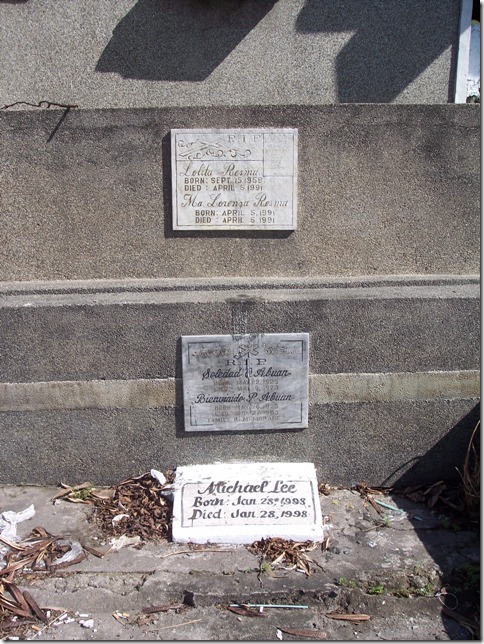 I don’t know what the official infant mortality stats are, but there were too many markers like these where you can see for yourself that they are too high.
I don’t know what the official infant mortality stats are, but there were too many markers like these where you can see for yourself that they are too high. 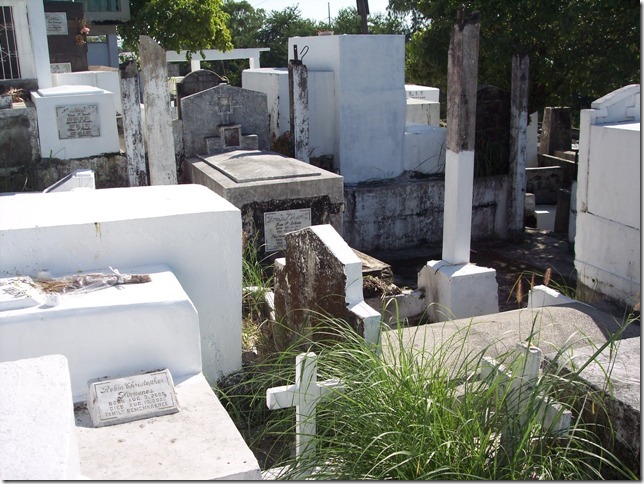 Lots of graves too close together for me to walk since I didn’t know if walking on them was acceptable . I only walked where I found paths.
Lots of graves too close together for me to walk since I didn’t know if walking on them was acceptable . I only walked where I found paths. 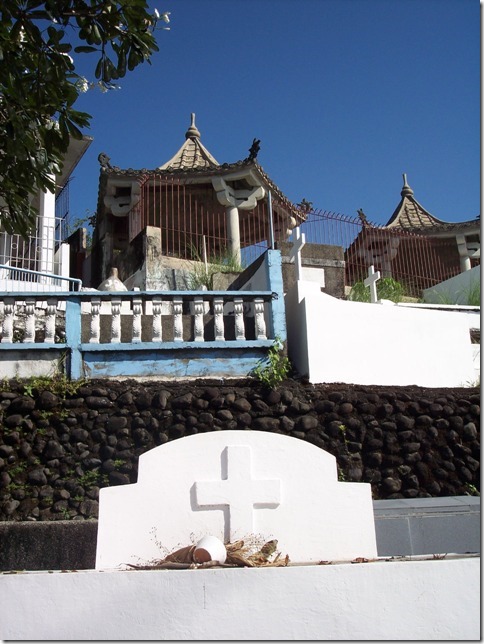 There were several influences here, Catholic and Chinese.
There were several influences here, Catholic and Chinese. 

